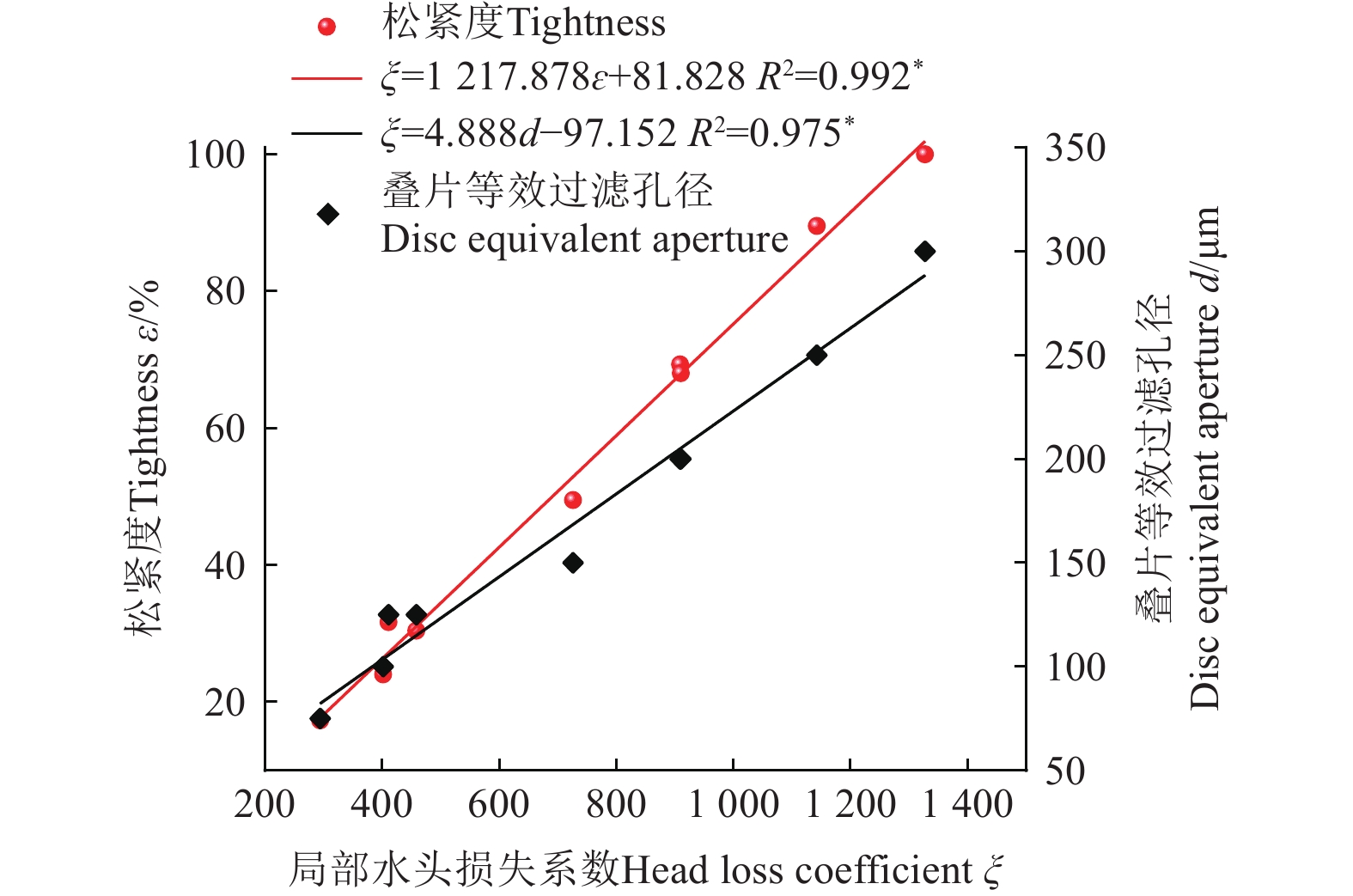Design of adjustable equivalent aperture disc filters and its hydraulic performance
-
摘要:
叠片过滤器是微灌系统的关键部件之一,对过滤杂质,减缓滴头堵塞起到重要作用。但叠片过滤器的叠片种类单一、过滤沙粒粒径范围较小,同一叠片无法满足不同杂质粒径的过滤要求。基于此,该研究考虑通过合理改变叠片间松紧度的方式调节叠片间有效过滤面积,设计了一种过滤孔径可调的叠片过滤器并通过试验测试其水力性能。结果表明:1)通过调节叠片松紧度可以获得不同过滤孔径的目标。3种叠片在3种电机压力下可获得7种松紧度,对应的叠片过滤等效孔径分别75、100、125、150、200、250、300 μm。2)7种孔径叠片过滤器水头损失动态变化和拦沙量存在差异。以小于75 μm沙粒为主的小级配含沙水,75 μm叠片的水头损失峰值最大,最大值均稳定在16 m左右。其拦沙量显著大于其他叠片(P<0.05)。以>75~150 μm沙粒为主的中级配含沙水,75、100和125 μm叠片水头损失均较大,最大值均超过了6 m,100和125 μm叠片拦沙量显著大于其他叠片(P<0.05)。以>150~300 μm沙粒为主的大级配含沙水,150、200、250和300 μm叠片的拦沙量都较大,水头损失也有所增加。3)基于TOPSIS法可实现叠片过滤器孔径的优化配置。小级配含沙水应选择75 μm叠片;中级配含沙水浓度较大时应选择125 μm叠片,浓度较小时应选择100 μm叠片;大级配含沙水浓度较大时应选择250和300 μm叠片,浓度较小时应选择150和200 μm叠片。研究可为减少过滤器水头损失和微灌系统中不同级配含沙水条件下叠片过滤器的合理选型和使用提供参考。
Abstract:A disc filter is one of the key components in micro-irrigation systems, and plays an important role in filtering impurities and reducing clogging of emitters. However, the disc filter cannot fully meet the filtration requirements of different impurity particle sizes, due to a single type of discs and a narrow range of sand grain sizes for filtration. In this research, a disc filter with an adjustable filter mesh size was proposed to reasonably change the tightness between discs. The disc filter also met the filtration requirements in the different ranges of impurity particle size, in order to reduce the manufacture and operation costs. A series of tests was carried out on the hydraulic performance of disc filters with different mesh. Five flow rates of 10, 15, 20, 25, and 30 m3/h were then set to test the head loss in the conditions of clear water with different mesh sizes of disc filters. In addition, the head loss and sand interception of disc filters were evaluated with different mesh numbers under different grades and contents. Three grades were selected as the small, medium, and large sandy water with less than 75, 75−150, and 150−300 μm sand particles and three sand contents of 0.8, 1.0, and 1.2 g/L. The results show that: (1) Different objectives of mesh filtration were achieved to adjust the disc tightness. Three types of discs were used to obtain 7 levels of tightness under three motor pressures, corresponding to filter mesh sizes of 50, 60, 75, 100, 120, 150, and 200. (2) There were some differences in the head loss dynamics and sand interception of the 7 mesh disc filters. In small graded sandy water, the 200-mesh disc piece shared the largest peak head loss, where all maximums were stabilized at about 16 m. The sand interceptions of the 200-mesh disc were 54, 73, and 84 g, which were significantly larger than that of others (P<0.05). In intermediate-graded sandy water, the head loss was greater than for 120, 150, and 200 mesh discs, with the maximum exceeding 6 m. The sand interceptions for 120 and 150 mesh discs were 72, 92, and 103 g, and 81, 92, and 95 g, respectively, which were significantly greater than that of the others (P<0.05). In large grades of sandy water, the 50, 60, 75, and 100 mesh discs all shared greater sand interceptions and increased head loss. (3) The optimization configuration of the filter mesh size was achieved using the TOPSIS. Therefore, a 200-mesh disc should be chosen in small graded sandy water. A 120-mesh disc should be chosen in intermediate-graded sandy water when the content was high, and a 150-mesh disc should be chosen when the content was low. A 50- or 60-mesh disc should be selected in large grades of sandy water when the content was high, and a 75- or 100-mesh disc should be chosen when the concentration was low. The best filtration was achieved to effectively avoid the hidden danger of head loss surge. The finding can provide a strong reference for the rational selection and use of disc filters under different sand contents in micro-irrigation systems, in order to reduce the head loss of the filter
-
Keywords:
- disc filter /
- hydraulic performance /
- tightness /
- equivalent aperture /
- comprehensive evaluation
-
0. 引 言
微灌是一种高效的节水灌溉技术,具有广阔的发展空间和应用前景,作为微灌系统的一部分,灌水器堵塞是阻碍微灌技术发展的原因之一[1-2],过滤器作为滴灌系统中对水源进行净化处理的最后一道屏障,是保证灌水器不被堵塞、微灌系统正常运行的核心设备[3-4]。叠片过滤器因具有安装灵活和易于自动反冲洗等优势得到广泛使用[5-6]。然而,叠片过滤器的叠片种类单一、产品规格不全、过滤范围较小,无法满足不同杂质粒径的过滤要求,在工程使用中常出现水头损失突增的现象[7-8],这可能致使灌溉系统不能正常运行。因此,叠片过滤器过滤杂质粒径单一的问题亟待解决。
近年来,大量学者对叠片过滤器性能进行研究,主要包括性能试验和内部流场数值模拟。在性能试验方面,YURDEM 等[9-11]通过试验和量纲分析,有效预测了叠片过滤器的水头损失;GÓMEZ等[12]对叠片过滤器和网式过滤器进行对比试验,认为叠片过滤器拦截能力更好;LIU等[6]比较了JY叠片过滤器和Arkal叠片过滤器的过滤性能,发现两者具有相似的过滤效果;杨培岭等[13]对5种叠片过滤器开展不同进水含沙量和过滤流量水力性能和过滤性能试验,得到叠片结构尺寸参数对过滤器性能有影响的结论,并建立了叠片过滤器性能评价函数;崔瑞等[14]研究了2种不同流道结构叠片过滤器在清水条件下水头损失,结果表明水头损失与流量呈幂函数关系。在内部流场数值模拟方面:李楠[15]通过数值计算方法研究了几何参数对叠片水力性能的影响,认为沟槽倾斜角度对水头损失几乎无影响,而最小断面底角和叠片宽度则均会影响叠片过流能力;徐鑫等[16-17]对离散型流道叠片和传统叠片2种叠片过滤器内部流场分布进行模拟,发现离散型流道叠片过滤器在最大流量时产生的水头损失相较于传统叠片过滤器下降20.8%。
前人通过性能研究发现过滤器存在水头损失激增的问题[7, 18-19],随后开始对叠片外部宏观结构和微观尺度改进,从而提升其性能,如反清洗功能和泥沙处理能力。LEE等[20]通过改进试验,认为半圆形沟槽叠片水力性能较梯形流道叠片好。张重[21]运用简化的koch分形曲线设计叠片流道断面的几何结构,认为1/2处梯形分形流道拦沙效果较好。杨培岭等[18]提出基于分形理论的叠片过滤器,相较于传统叠片过滤器具有水头损失小、拦沙量高和拦截粒径小等优点。王钦等[22]设计了一种离散型流道叠片过滤器,具有有效过滤周期长、水头损失峰值低,且对细粒径泥沙的拦截效果较好的特点。杨德峰等[23]发明了一种具有反冲洗功能的叠片复合式竖向前置过滤器,该叠片过滤器能够原位反冲洗,冲洗效果好。崔春亮等[24]对叠片流道的“V”形角度进行了设计,自主研发了“V”形角度小于传统叠片的新型叠片,通过增大流道过流面积达到减小水头损失的效果。上述研究成果虽在一定程度上提升了叠片过滤器的性能,但叠片过滤器仍存在叠片种类单一、产品规格不全、过滤沙粒粒径范围较小的问题,若过滤器与过滤水质不匹配,会导致水头损失突增,使过滤系统压力瞬间增大,可能致使水肥一体机停止工作,灌溉系统不能正常运行,在大规模的推广应用中受到阻碍。
基于此,本文提出了一种通过合理调节叠片间松紧度来改变有效过滤面积的方法,开发了一种叠片过滤孔径可调的叠片过滤器,使之能满足不同杂质粒径范围的过滤需求。同时,为了避免水头损失激增的隐患,并确保最佳过滤效果,本文采用了多目标综合评价方法来选配不同含沙水条件下叠片过滤器等效过滤孔径,以期为微灌系统中不同级配含沙水条件叠片过滤器的合理选型和配置提供参考。
1. 材料与方法
1.1 过滤孔径可调的叠片过滤器结构设计
1.1.1 过滤孔径可调的叠片过滤器
现阶段的叠片过滤器存在过滤孔径较为单一、自动反冲洗叠片过滤器造价高等缺陷,基于此,本研究团队发明了一种通过调节叠片松紧度实现叠片过滤器流道尺寸可调的叠片过滤器,结构及剖面图如图1所示。该叠片过滤器主要包括进水口、分流器、底座、滤芯、松紧度调节装置、滤芯、出水口、排污口。其中,松紧度调节装置由步进电机、减速器、联轴杆和机座组成。其工作原理是通过步进电机驱动,利用步进电机驱动器根据预设的脉冲数控制步进电机的转动;减速器则用于增大步进电机的动力输出并进一步提高控制精度;再通过自动控制系统控制步进电机驱动分流器调节弹簧的压紧程度进而调节叠片间有效过滤面积,进而达到改变叠片的流道孔径以匹配不同类型的灌水器的目的,同时确保叠片不至于被压变形。分流器则起到减小因水流直冲产生的能量损失和使水流均匀分散的作用。
1.1.2 松紧度
步进电机加压后叠片流道截面面积发生改变进而导致过滤器对泥沙的过滤效果改变,为明确电机加压与叠片过滤器水力和过滤性能之间的关系,本文引入松紧度指标,并将不同叠片在不同电机压力下的单流道平均有效过滤面积与叠片中单流道最大平均有效过滤面积比值定义为松紧度,计算式如式(1)所示:
εi=¯Ai¯A0×100% (1) 式中εi为松紧度,%;¯Ai为不同叠片在不同电机压力下的单个流道平均有效过滤面积,mm2;¯A0为单流道最大平均有效过滤面积,mm2。
袁寄望等[8]提出了清水条件下采用断面间距加权的几何平均方法计算流道有效过水断面面积的方法,该方法可用于计算自然状态下叠片过滤器的有效过滤面积。本文叠片间因电机加压作用存在不同程度的塞嵌,塞嵌后叠片间流道结构和尺寸发生了改变。此外,考虑到在电机加压后过滤器叠片间受力的不均匀性可能会导致不同位置处叠片间的塞嵌程度不一致,本文在每次试验前对叠片过滤器从上至下随机选取10个位置相邻两叠片间进行拍照并放在显微镜(ZEISS Axio Scope. A1 MAT,德国)下测量其沟槽尺寸,图2给出了在电机脉冲数为2 000时1种叠片过滤器从上至下沟槽尺寸效果示意图及沟槽内部结构示意图,通过对所测数据进行拟合得到过滤器从上至下不同位置处叠片流道尺寸的关系式,通过积分可求得从上至下叠片间单个流道的总有效过滤面积并求出单个平均流道平均有效过滤面积,因此不同松紧度叠片的有效过滤面积计算方法如式(2)~式(4)。
![]() 图 2 叠片过滤器从上至下沟槽尺寸效果示意图注:a1为叠片流道第1(进水口)个断面的过水面积,mm2;an为叠片流道第n个断面的过水面积,mm2;aN为叠片流道第N(出水口)个断面的过水面积,mm2。Figure 2. Schematic diagram of groove size effect of disc filter from top to bottomNote: a1 is the water-crossing area of the 1st section(water inlet) of the disc flow channel;an is the water-crossing area of the nth section of the disc flow channel;aN is the water-crossing area of the Nth section(water outlet) of the disc flow channel.
图 2 叠片过滤器从上至下沟槽尺寸效果示意图注:a1为叠片流道第1(进水口)个断面的过水面积,mm2;an为叠片流道第n个断面的过水面积,mm2;aN为叠片流道第N(出水口)个断面的过水面积,mm2。Figure 2. Schematic diagram of groove size effect of disc filter from top to bottomNote: a1 is the water-crossing area of the 1st section(water inlet) of the disc flow channel;an is the water-crossing area of the nth section of the disc flow channel;aN is the water-crossing area of the Nth section(water outlet) of the disc flow channel.¯Aij=12(N−1∏n=1(an+an+1)(xn+1−xn))1L (2) ¯Ai=∫Pt−11f(¯Aij)d¯AijPt (3) 式中f(¯Aij)不同叠片在不同电机压力作用下从上至下叠片间单个流道有效过滤面积与叠片数拟合关系式,通过积分可求得从上至下叠片间单个流道的总有效过滤面积;L为流道长度,mm;an为流道内第n个断面的过滤面积,mm2;xn为第n个断面距进水口距离,mm;N为流道上划分断面个数;Pt为总叠片数 。
过滤器总有效过滤面积计算式为
Ai=¯Ai⋅fp⋅Pt106 (4) 式中Ai为不同叠片在不同电机压力作用下过滤器总有效过滤面积,m2;fp为相邻两叠片间流道数。
1.2 试验材料与装置
试验装置如图3所示,包括蓄水桶、搅拌机、离心泵、压力传感器、松紧度可调的叠片过滤器、松紧度调节装置、电磁流量计、数据采集系统以及一根进水管和一根回水管。其中,蓄水桶容积为100 L;变频柜控制水泵可调节试验需要的流量,离心式水泵的额定流量50 m3/h,额定扬程32 m,功率7.5 kW;电磁流量计的额定工作压力为1.6 MPa;过滤器进口直径为34 mm,额定流量为30 m3/h,选择3种不同型号的叠片,其主要结构尺寸参数如表1所示;压力传感器的量程为0~0.1 MPa、压力数据精度为0.1%;数据自动采集系统包括计算机、数据采集模块和相关软件,数据采集时间间隔可人为设定。石英砂因硬度大、抗磨损、性质稳定等特点不易受到搅拌机和离心泵等试验装置的影响,故试验选用石英砂配置含沙水[8]。
![]() 图 3 试验装置图1.蓄水桶 2.搅拌机 3.离心泵 4.压力传感器 5.松紧度可调的叠片过滤器 6.松紧度调节装置 7.电磁流量计 8.阀门 9.数据采集系统Figure 3. Test device diagram1.Water storage barrel 2.Mixing motor 3.Centrifugal pump 4.Pressure sensor 5.Disc filter with adjustable tightness 6.Tightness adjustment device 7.Electromagnetic flow meter 8.Valve 9.Data acquisition system表 1 3种叠片F1~F3主要结构尺寸参数Table 1. Main structural dimension parameters of three kinds of discs F1-F3
图 3 试验装置图1.蓄水桶 2.搅拌机 3.离心泵 4.压力传感器 5.松紧度可调的叠片过滤器 6.松紧度调节装置 7.电磁流量计 8.阀门 9.数据采集系统Figure 3. Test device diagram1.Water storage barrel 2.Mixing motor 3.Centrifugal pump 4.Pressure sensor 5.Disc filter with adjustable tightness 6.Tightness adjustment device 7.Electromagnetic flow meter 8.Valve 9.Data acquisition system表 1 3种叠片F1~F3主要结构尺寸参数Table 1. Main structural dimension parameters of three kinds of discs F1-F3叠片主要结构参数
Main structural parameters of discF1 F2 F3 厚度Thickness/mm 2.19 2.03 1.50 流道长度Length of flow channel/mm 15.00 15.00 15.00 流道数Number of flow channels 380 470 560 流道外截面三角形高
Height of triangle outer section /mm0.84 0.62 0.35 流道内截面三角形高
Height of triangle iner section /mm0.58 0.42 0.25 1.3 试验设计及过程
1.3.1 不同松紧度下叠片过滤器等效过滤孔径确定试验
综合考虑步进电机行程和叠片不至于被压变形,研究采取3个行程距离,对应步进电机脉冲数为0、2 000和
4000 。为明确不同叠片在不同电机加压下的等效过滤孔径,本研究将泥沙按粒径分为0~54、>54~75、>75~100、>100~125、>125~154、>154~180、>180~200、>200~250和>250~300 μm共9个粒径段,分别对3种叠片在3种不同电机压力下进行不同粒径段的过滤试验,收集叠片拦截沙并将不同叠片过滤器的等效过滤孔径定义为拦截率大于90%的沙粒段中最小粒径段的上限值[25-26]。1.3.2 不同松紧度叠片过滤器水力性能试验设计
1)清水试验:实际灌溉中过滤器常采用大流量[27],故本试验根据过滤器的额定流量(30 m3/h),分别设置过滤器进口流量为 10、15、20、25和30 m3/h,并测验不同等效过滤孔径叠片过滤器在不同流量下的进出口压强水头,得到对应的水头损失值。每种工况重复试验3次计算平均值。
2)含沙水试验:分析不同工况下不同等效过滤孔径叠片过滤器水头损失、拦沙量和拦截沙粒径等变化。喻黎明等[28-29]等通过数值模拟和试验研究发现设置用水含沙量为0.6 g/L时比较贴近现实中灌溉水源的含沙量,为加速堵塞以缩短试验周期,选用大浓度含沙水进行试验,设置3个沙粒浓度,分别为 0.8、1.0和1.2 g/L。张凯等[4]认为灌溉用水末级管道中沙粒粒径应小于125 μm,中级管道应小于250 μm,并提出研究中泥沙粒径范围应适当扩大,故本文选取0~300 μm范围内的泥沙进行试验,并设计分别以小粒径(0~75 μm) 、中等粒径(>75~150 μm)和大粒径(>150~300 μm)为主的3种级配含沙水,模拟不同中值粒径的灌溉水,不同级配含沙水的泥沙粒径组成和占比见表2。
表 2 不同级配含沙水沙粒占比Table 2. Proportion of sand particles in different gradations of water containing sand编号
No.占比 Proportion/% 0~
54 μm>54~
75 μm>75~
100 μm>100~
150 μm>150~
200 μm>200~
300 μmⅠ 35.0 35.0 7.5 7.5 7.5 7.5 Ⅱ 7.5 7.5 35.0 35.0 7.5 7.5 Ⅲ 7.5 7.5 7.5 7.5 35.0 35.0 1.4 评价指标及方法
1.4.1 评价指标选取
1)拦沙量:过滤器的拦沙量是指在整个过滤周期内,滤芯所截留的沙粒总量,g。本文通过测定叠片过滤器的周期拦沙量来评判其拦沙能力。
2)水头损失:过滤前后过滤器两端压力之差。利用压力传感器从试验开始运行到试验结束实时监测。水头损失和局部水头损失系数[30]可表示为
hj=ξQ22gA2 (5) ξ=2g⋅A2⋅hjQ2 (6) 式中hj为水头损失,m;ξ为局部水头损失系数;Q为进口流量,m3/s;A为过滤器有效过滤面积,m2;g为重力加速度,取9.8 m/s2。
3)堵塞运行时段水头损失增长速率(δ2):根据水头损失动态变化趋势,过滤器可分为稳定运行时段( t1,水头损失出现拐点之前)和堵塞运行时段( t2,水头损失出现拐点之后至堵塞),定义δ2为堵塞运行时段的增长速率,该指标用以反映过滤器运行周期[13],其表达式如下:
δ2=h2jt2 (7) 式中h2j为过滤器堵塞运行时段水头损失增长值,m;t2为水头损失从出现拐点至堵塞稳定运行时长,s。δ2值越小,过滤性能越稳定,运行周期越长。
4)堵塞均匀度:堵塞均匀度可以反映堵塞物在叠片沟槽内分布的均匀程度[13, 18]。将稳定运行时段和堵塞运行时段的水头损失增长速率的比值定义为堵塞均匀度,计算式如式(8)。
η=δ2δ1 (8) 式中η为堵塞均匀度,η值越接近于1,过滤器拦截的杂质在流道内分布越均匀;δ1为稳定运行时段水头损失增长速率,m/s。
1.4.2 TOPSIS综合评价法
TOPSIS分析法结合权重指标计算结果能精确反映各方案之间的差距[31]。应用TOPSIS分析法分别评价3种级配(级配Ⅰ、Ⅱ和Ⅲ)下不同叠片过滤器在3种含沙量(0.8、1.0和1.2 g/L)的综合性能表现,分析叠片过滤器在过滤不同级配和含沙量时的最佳孔径配置。同时,考虑不同指标之间的差异性,采用熵权法为各项评价指标赋权,计算出不同因子对叠片过滤器综合性能的影响程度排序。
2. 结果与分析
2.1 不同松紧度下叠片等效过滤孔径确定
2.1.1 3种叠片在不同电机脉冲数下松紧度确定
利用光学显微镜观测3种电机脉冲数下叠片过滤器从上至下的流道尺寸,由式(2)计算得3种叠片在不同电机压力下不同位置处单个流道有效过滤面积如图4所示。
由图4可知3种叠片过滤器在自然状态下(步进电机脉冲数为0)从上至下叠片间流道尺寸(单个流道有效过滤面积)几乎一致。电机加压后,叠片过滤器流道尺寸减小,且过滤器越靠近上方电机处叠片间流道尺寸减小程度越大,拟合得不同位置处叠片单个流道有效过滤面积与过滤器从上至下叠片数之间的关系式(R2>0.98)。此外,由图可知,过滤器F1在自然状态的单个流道平均有效过滤面积最大,为0.949 mm2。根据松紧度定义可知,¯A0为0.949 mm2,代入式(1)和式(3)得F1在3种压力下对应的松紧度分别为100%、89.54%和69.30%,F2对应的松紧度分别为68.03%、49.49%和31.65%,F3对应的松紧度分别为30.40%、24.03%和17.30%。
2.1.2 不同松紧度叠片等效过滤孔径确定
通过试验得到不同粒径段含沙水条件下不同松紧度叠片过滤器拦截沙粒占比试验配沙百分数(表3),由表3可知,通过松紧度调节装置可有效改变过滤器的流道尺寸,使叠片能拦截更细小的沙粒。
表 3 不同松紧度叠片对不同粒径段拦截沙粒占试验用沙百分数Table 3. Percentage of sand particles intercepted by discs with different particle sizes in the test sand under different tightness% εi/% 9种沙粒粒径段范围 Size range of 9 kinds of sand particles/μm 0~54 >54~
75>75~
100>100~
125>125~
150>150~
180>180~
200>200~
250>250~
300100.00 2.1 1.9 3.1 5.7 7.0 21.0 44.2 87.0 96.1 89.54 1.8 1.2 8.4 10.8 14.2 20.9 75.3 91.3 96.5 69.30 1.3 0.9 12.1 11.9 28.7 87.5 94.8 85.2 64.4 68.03 13.8 13.0 28.4 54.0 73.5 89.4 96.4 75.2 56.8 49.49 10.7 24.4 43.4 78.2 91.1 93.1 68.1 75.2 30.2 31.65 15.7 34.2 69.2 94.5 95.6 91.5 77.0 55.4 22.7 30.40 59.2 75.2 89.2 97.9 80.0 62.9 34.9 17.7 8.1 24.03 67.8 81.1 93.2 75.9 67.7 49.6 43.9 17.7 3.0 17.30 86.5 91.9 88.6 74.3 69.1 46.9 41.8 13.1 0.9 注:εi为松紧度。 Note: εi refers to tightness. 不同松紧度叠片过滤器拦截率大于90%的沙粒段种最小粒径段分别为>250~300、>200~250、>180~200、>180~200、>125~150、>100~125、>100~125、>75~100和>54~75 μm。为安全起见,分别取粒径段的上限值作为过滤器能拦截的最小粒径并获取与筛网孔径对应的当量孔径,因此不同松紧度叠片过滤器的当量过滤孔径见表4。由表4可知,当叠片松紧度为100%时,此时叠片流道有效过滤面积最大,当量过滤孔径也最大,为300 μm,随着松紧度的减小,叠片当量过滤孔径逐渐减小,能拦截的泥沙粒径也随之减小,当叠片松紧度为17.30%时可拦截75 μm泥沙。
表 4 不同松紧度叠片过滤器当量孔径和对应过滤孔径Table 4. Equivalent aperture and corresponding filter mesh number of different tightness of disc filters叠片松紧度
Tightness/%当量孔径
Equivalent apertures/μm100.00 300 89.54 250 69.30 200 68.03 200 49.49 150 31.65 125 30.40 125 24.03 100 17.30 75 2.2 不同等效过滤孔径叠片过滤器水头损失
2.2.1 清水条件下水头损失
根据水头损失系数计算式(6)计算得不同等效过滤孔径叠片过滤器在进口流量为10、15、20、25和30 m3/h下的局部水头系数,由表5可知同一等效过滤孔径叠片过滤器局部水头损失系数的计算值最大相对误差仅为5.91%,说明数据离散程度小,误差值在可接受范围内。此外,可发现不同等效过滤孔径叠片过滤器的局部水头损失系数存在显著差异,且随等效过滤孔径的增大而增大。为明晰局部水头损失系数随等效过滤孔径(即松紧度)的变化情况,进一步给出了叠片过滤器等效过滤孔径(即松紧度)与局部水头损失系数的相关关系,如图5所示。
表 5 清水条件下局部水头损失系数计算结果Table 5. Calculation results of local head loss coefficient under clear water conditionεi/% d/μm Ai
/mm2Q
/(m3·h−1)hj/m ξ ¯ξ εi/% d/μm Ai
/mm2Q
/(m3·h−1)hj/m ξ ¯ξ εi/% d/μm Ai
/mm2Q
/(m3·h−1)hj/m ξ ¯ξ 100.00 300 0.049 10 0.214 1326.71 1331.59 68.03 200 0.041 10 0.201 894.05 910.03 30.40 125 0.027 10 0.218 422.72 457.69 15 0.479 1319.82 15 0.458 905.42 15 0.542 467.11 20 0.613 1323.61 20 0.822 914.07 20 0.954 462.47 25 1.036 1332.16 25 1.289 917.36 25 1.534 475.93 30 1.968 1355.64 30 1.86 919.26 30 2.136 460.21 89.54 250 0.044 10 0.228 1133.31 1140.52 49.49 150 0.030 10 0.311 722.44 726.27 24.03 100 0.021 10 0.334 399.91 400.42 15 0.506 1117.84 15 0.699 721.67 15 0.708 376.76 20 0.904 1123.37 20 1.258 730.57 20 1.343 402.00 25 1.478 1175.46 25 2.022 751.53 25 2.154 412.64 30 2.087 1152.64 30 2.732 705.15 30 3.088 410.81 69.30 200 0.034 10 0.308 917.04 909.51 31.65 125 0.019 10 0.438 416.09 411.79 17.30 75 0.015 10 0.439 272.37 287.50 15 0.689 911.74 15 0.966 407.85 15 1.075 296.43 20 1.235 919.27 20 1.740 413.24 20 1.895 293.93 25 1.892 901.32 25 2.658 404.00 25 3.054 303.17 30 2.715 898.18 30 2.958 417.77 30 3.94 271.61 注:εi指松紧度,d指叠片等效过滤孔径,Ai指过滤器总有效过滤面积,Q指进口流量,hj指水头损失,ξ指局部水头损失系数,¯ξ指平均局部水头损失系数。 Note: εi refers to tightness. d refers to disc equivalent aperture. Ai refers to total effective filtering area of filter. Q refers to inlet flow rate. hj refers to head loss. ξ refers to local head loss coefficient. ¯ξ is average local head loss coefficient. 由图5可知,等效过滤孔径与局部水土损失系数之间的R2大于0.95,说明局部水头损失系数与等效过滤孔径存在线性关系,进一步将局部水头损失系数代入水头损失式中得到水头损失的表达式如式(9)。
hj=(4.888−97.152d)Q22gA2 (9) 2.2.2 含沙水条件下水头损失
7种等效过滤孔径叠片过滤器在不同级配、不同含沙量下水头损失动态变化如图6所示。从图看出,对于同一级配含沙水,随着含沙量的增加,不同等效过滤孔径叠片水头损失均增大,堵塞阶段时长均变短。对于级配Ⅰ含沙水,75、100和125 μm叠片过滤器水头损失均显著增大,但75 μm叠片过滤器水头损失增加幅度大且时长最短,其水头损失最大值稳定在16 m左右;250和300 μm叠片过滤器的水头损失基本不发生变化,这表明当叠片过滤器的孔径较大 时,由于流道较大,泥沙能够随着水流顺利通过叠片,因此叠片的拦截作用不明显,泥沙基本上不会留在叠片流道内部,从而也不会对其造成堵塞。
![]() 图 6 不同含沙量和级配含沙水条件下7种等效过滤孔径叠片过滤器水头损失动态变化注:GⅠ-C0.8指含沙量为0.8 g·L−1,沙粒级配为Ⅰ,以此类推。下同。Figure 6. Dynamic change of head loss of disc filters with 7 equivalent filtration apertures under different sediment concentration and sand gradingNote: GⅠ-C0.8 means that the sand content is 0.8 g·L−1, the sand grading is Ⅰ, and so on. Same as below.
图 6 不同含沙量和级配含沙水条件下7种等效过滤孔径叠片过滤器水头损失动态变化注:GⅠ-C0.8指含沙量为0.8 g·L−1,沙粒级配为Ⅰ,以此类推。下同。Figure 6. Dynamic change of head loss of disc filters with 7 equivalent filtration apertures under different sediment concentration and sand gradingNote: GⅠ-C0.8 means that the sand content is 0.8 g·L−1, the sand grading is Ⅰ, and so on. Same as below.对于级配Ⅱ含沙水,75、100、125、150和200 μm叠片的水头损失均明显增大,水头损失最大值均超过了6 m;但75 μm叠片的水头损失相较于级配Ⅰ有所减缓,可能是大粒径沙粒无法进入75 μm叠片内部,而是截留在进水口,若泥沙淤积过多势必会对进水口造成堵塞。对于级配Ⅲ含沙水,200、250和300 μm叠片水头损失增加明显,75和100 μm叠片虽然也有所增加,但增幅减缓。说明对于大粒径级配含沙水,大孔径叠片开始对泥沙起拦截作用,泥沙堵塞在沟槽内部。
2.3 拦沙量
图7所示为含沙水条件下7种孔径过滤器周期拦沙量。由图7可知,不同孔径叠片的拦沙量均随含沙量的增大而增大。相同含沙量下,对于主要由小于75 μm的沙粒组成的级配Ⅰ含沙水,75 μm叠片的拦沙效果最好,对于0.8、1.0和1.2 g/L 3种含沙量下拦沙量分别为54、73和84 g,即叠片拦截率分别为67.5%、73.0%和70.0%;大于75 μm叠片拦沙量显著小于75 μm叠片(P<0.05),且随着叠片孔径的减小,拦截效果逐渐降低。因此,当叠片流道尺寸大于泥沙粒径时,拦截效果不佳。对于级配Ⅱ(主要由>75~150 μm的沙粒组成),100和125 μm叠片拦沙量显著大于其他5种等效过滤孔径叠片(P<0.05),3种含沙量下125 μm叠片拦沙量分别为72、92和103 g,100 μm叠片拦沙量分别为81、92和95 g。对于级配Ⅲ(主要由>150~300 μm的沙粒组成),150、200、250和300 μm叠片的拦截效果都比较好,但是当含沙量较大(1.2 g/L)时,250和300 μm叠片拦沙量显著大于150和200 μm叠片(P<0.05);含沙量较小时(0.8 g/L),150和200 μm叠片拦沙量显著大于250和300 μm叠片(P<0.05)。这对于大粒径级配含沙水而言,当浓度较大的时候,选择大孔径的叠片,拦沙率会比较高;而当浓度较小时,可以适当选择较小孔径的叠片。
![]() 图 7 不同含沙量和级配含沙水条件下7种等效过滤孔径叠片过滤器拦沙量注:不同小写字母表示在0.05水平,相同含沙量下不同孔径处理间存在显著性差异。Figure 7. Sand interception of disc filters with 7 equivalent filtration apertures under different sediment concentration and sand gradingNote: Different small letter indicate significant difference among different apertures treatments at 0.05 level under same sandy water condition.
图 7 不同含沙量和级配含沙水条件下7种等效过滤孔径叠片过滤器拦沙量注:不同小写字母表示在0.05水平,相同含沙量下不同孔径处理间存在显著性差异。Figure 7. Sand interception of disc filters with 7 equivalent filtration apertures under different sediment concentration and sand gradingNote: Different small letter indicate significant difference among different apertures treatments at 0.05 level under same sandy water condition.2.4 基于TOPSIS法的叠片过滤器孔径优化配置性能综合评价
由熵权法计算出权重系数并代入TOPSIS分析法评价不同孔径叠片过滤器在3种级配和3种含沙量的综合性能表现如表6所示。
表 6 不同等效过滤孔径叠片过滤器优化配置性能表现TOPSIS综合分析Table 6. TOPSIS comprehensive analysis of optimal configuration performance of disc filters with different equivalent apertures级配
Sand grading含沙量
Sand density/
(g·L−1)等效过滤孔径
Disc equivalent aperture/μm综合
得分
Scoring
index级配
Sand grading含沙量
Sand density/
(g·L−1)等效过滤孔径
Disc equivalent aperture/μm综合
得分
Scoring
index级配
Sand grading含沙量
Sand density/
(g·L−1)等效过滤孔径
Disc equivalent aperture/μm综合得分
Scoring indexⅠ 0.8 75 0.445 Ⅱ 0.8 75 0.266 Ⅲ 0.8 75 0.506 100 0.445 100 0.568 100 0.461 125 0.439 125 0.565 125 0.441 150 0.276 150 0.342 150 0.582 200 0.338 200 0.427 200 0.602 250 0.259 250 0.489 250 0.419 300 0.267 300 0.489 300 0.521 1.0 75 0.594 1.0 75 0.501 1.0 75 0.504 100 0.443 100 0.451 100 0.580 125 0.438 125 0.352 125 0.463 150 0.394 150 0.305 150 0.386 200 0.325 200 0.352 200 0.473 250 0.273 250 0.451 250 0.637 300 0.270 300 0.501 300 0.532 1.2 75 0.674 1.2 75 0.185 1.2 75 0.492 100 0.589 100 0.519 100 0.504 125 0.559 125 0.547 125 0.406 150 0.390 150 0.244 150 0.481 200 0.359 200 0.421 200 0.455 250 0.276 250 0.420 250 0.540 300 0.272 300 0.483 300 0.609 由表6可知,对于级配Ⅰ含沙水综合得分最高的是75 μm叠片,0.8、1.0和1.2 g/L 3种含沙量下分别是0.445、0.594和0.674,说明对于以小于75 μm小粒径为主的含沙水应选择75 μm叠片。对于级配Ⅱ含沙水,综合得分较高的是100和125 μm叠片,其中当含沙量较低时(0.8和1.0 g/L),100 μm叠片综合得分大于125 μm叠片,当含沙量为1.2 g/L时,125 μm叠片综合得分大于0.100 mm叠片。因此对于以>75~150 μm中等粒径为主的含沙水,当浓度较大时应选择125 μm叠片,浓度较小时应选择100 μm叠片。对于级配Ⅲ含沙水,当含沙量较小时,综合得分较高的分别是200和150 μm叠片,综合得分分别是0.602和0.582;当含沙量较大时,综合得分较高的分别是300和250 μm叠片,综合得分分别时0.609和0.540。因此对于以>150~300 μm大粒径为主的含沙水,当浓度较大时应选择250和300 μm叠片,浓度较小时应选择150和200 μm叠片。此外,随着浓度的增大,大孔径叠片综合性能较好,可能原因是浓度较小时,大粒径对沟槽的堵塞程度不够,较小粒径还是能随水流穿过流道,因此拦沙效果不佳;当浓度增大时小孔径叠片因有效过滤面积快速减小导致水头损失快速增加,故综合得分不如大孔径叠片。
3. 结 论
设计了一种通过合理调节叠片间松紧度改变有效过滤孔径的叠片过滤器,并开展3种含沙量和3种沙粒级配含沙水试验测试不同松紧度叠片过滤器的性能,结论如下:
1)通过调节叠片松紧度可以获得不同等效过滤孔径叠片的目标。3种叠片在3种电机压力下可获得7种等效过滤孔径,分别为75、100、125、150、200、250和300 μm。
2)7种等效过滤孔径叠片过滤器在不同级配、含沙量下水头损失动态变化和拦沙量存在差异。以小于75 μm沙粒为主的含沙水,75 μm叠片的水头损失和拦沙量显著大于其他叠片(P<0.05);以>75~150 μm沙粒为主的含沙水,75、100和125 μm叠片水头损失均较大,100和125 μm叠片拦沙量显著大于其他叠片(P<0.05);以>150~300 μm沙粒为主的含沙水,150、200、250和300 μm叠片的拦沙量都较大,水头损失也有所增加。
3)基于TOPSIS法对叠片过滤器孔径优化配置进行综合评价。评价结果表明:以小于75 μm粒径为主的含沙水应选择75 μm叠片。以>75~150 μm粒径为主的含沙水,浓度较大时应选择125 μm叠片,浓度较小时应选择100 μm叠片。以>150~300 μm大粒径为主的含沙水,浓度较大时应选择250或300 μm叠片,浓度较小时应选择150或200 μm叠片。
-
图 2 叠片过滤器从上至下沟槽尺寸效果示意图
注:a1为叠片流道第1(进水口)个断面的过水面积,mm2;an为叠片流道第n个断面的过水面积,mm2;aN为叠片流道第N(出水口)个断面的过水面积,mm2。
Figure 2. Schematic diagram of groove size effect of disc filter from top to bottom
Note: a1 is the water-crossing area of the 1st section(water inlet) of the disc flow channel;an is the water-crossing area of the nth section of the disc flow channel;aN is the water-crossing area of the Nth section(water outlet) of the disc flow channel.
图 3 试验装置图
1.蓄水桶 2.搅拌机 3.离心泵 4.压力传感器 5.松紧度可调的叠片过滤器 6.松紧度调节装置 7.电磁流量计 8.阀门 9.数据采集系统
Figure 3. Test device diagram
1.Water storage barrel 2.Mixing motor 3.Centrifugal pump 4.Pressure sensor 5.Disc filter with adjustable tightness 6.Tightness adjustment device 7.Electromagnetic flow meter 8.Valve 9.Data acquisition system
图 6 不同含沙量和级配含沙水条件下7种等效过滤孔径叠片过滤器水头损失动态变化
注:GⅠ-C0.8指含沙量为0.8 g·L−1,沙粒级配为Ⅰ,以此类推。下同。
Figure 6. Dynamic change of head loss of disc filters with 7 equivalent filtration apertures under different sediment concentration and sand grading
Note: GⅠ-C0.8 means that the sand content is 0.8 g·L−1, the sand grading is Ⅰ, and so on. Same as below.
图 7 不同含沙量和级配含沙水条件下7种等效过滤孔径叠片过滤器拦沙量
注:不同小写字母表示在0.05水平,相同含沙量下不同孔径处理间存在显著性差异。
Figure 7. Sand interception of disc filters with 7 equivalent filtration apertures under different sediment concentration and sand grading
Note: Different small letter indicate significant difference among different apertures treatments at 0.05 level under same sandy water condition.
表 1 3种叠片F1~F3主要结构尺寸参数
Table 1 Main structural dimension parameters of three kinds of discs F1-F3
叠片主要结构参数
Main structural parameters of discF1 F2 F3 厚度Thickness/mm 2.19 2.03 1.50 流道长度Length of flow channel/mm 15.00 15.00 15.00 流道数Number of flow channels 380 470 560 流道外截面三角形高
Height of triangle outer section /mm0.84 0.62 0.35 流道内截面三角形高
Height of triangle iner section /mm0.58 0.42 0.25 表 2 不同级配含沙水沙粒占比
Table 2 Proportion of sand particles in different gradations of water containing sand
编号
No.占比 Proportion/% 0~
54 μm>54~
75 μm>75~
100 μm>100~
150 μm>150~
200 μm>200~
300 μmⅠ 35.0 35.0 7.5 7.5 7.5 7.5 Ⅱ 7.5 7.5 35.0 35.0 7.5 7.5 Ⅲ 7.5 7.5 7.5 7.5 35.0 35.0 表 3 不同松紧度叠片对不同粒径段拦截沙粒占试验用沙百分数
Table 3 Percentage of sand particles intercepted by discs with different particle sizes in the test sand under different tightness
% εi/% 9种沙粒粒径段范围 Size range of 9 kinds of sand particles/μm 0~54 >54~
75>75~
100>100~
125>125~
150>150~
180>180~
200>200~
250>250~
300100.00 2.1 1.9 3.1 5.7 7.0 21.0 44.2 87.0 96.1 89.54 1.8 1.2 8.4 10.8 14.2 20.9 75.3 91.3 96.5 69.30 1.3 0.9 12.1 11.9 28.7 87.5 94.8 85.2 64.4 68.03 13.8 13.0 28.4 54.0 73.5 89.4 96.4 75.2 56.8 49.49 10.7 24.4 43.4 78.2 91.1 93.1 68.1 75.2 30.2 31.65 15.7 34.2 69.2 94.5 95.6 91.5 77.0 55.4 22.7 30.40 59.2 75.2 89.2 97.9 80.0 62.9 34.9 17.7 8.1 24.03 67.8 81.1 93.2 75.9 67.7 49.6 43.9 17.7 3.0 17.30 86.5 91.9 88.6 74.3 69.1 46.9 41.8 13.1 0.9 注:εi为松紧度。 Note: εi refers to tightness. 表 4 不同松紧度叠片过滤器当量孔径和对应过滤孔径
Table 4 Equivalent aperture and corresponding filter mesh number of different tightness of disc filters
叠片松紧度
Tightness/%当量孔径
Equivalent apertures/μm100.00 300 89.54 250 69.30 200 68.03 200 49.49 150 31.65 125 30.40 125 24.03 100 17.30 75 表 5 清水条件下局部水头损失系数计算结果
Table 5 Calculation results of local head loss coefficient under clear water condition
εi/% d/μm Ai
/mm2Q
/(m3·h−1)hj/m ξ ¯ξ εi/% d/μm Ai
/mm2Q
/(m3·h−1)hj/m ξ ¯ξ εi/% d/μm Ai
/mm2Q
/(m3·h−1)hj/m ξ ¯ξ 100.00 300 0.049 10 0.214 1326.71 1331.59 68.03 200 0.041 10 0.201 894.05 910.03 30.40 125 0.027 10 0.218 422.72 457.69 15 0.479 1319.82 15 0.458 905.42 15 0.542 467.11 20 0.613 1323.61 20 0.822 914.07 20 0.954 462.47 25 1.036 1332.16 25 1.289 917.36 25 1.534 475.93 30 1.968 1355.64 30 1.86 919.26 30 2.136 460.21 89.54 250 0.044 10 0.228 1133.31 1140.52 49.49 150 0.030 10 0.311 722.44 726.27 24.03 100 0.021 10 0.334 399.91 400.42 15 0.506 1117.84 15 0.699 721.67 15 0.708 376.76 20 0.904 1123.37 20 1.258 730.57 20 1.343 402.00 25 1.478 1175.46 25 2.022 751.53 25 2.154 412.64 30 2.087 1152.64 30 2.732 705.15 30 3.088 410.81 69.30 200 0.034 10 0.308 917.04 909.51 31.65 125 0.019 10 0.438 416.09 411.79 17.30 75 0.015 10 0.439 272.37 287.50 15 0.689 911.74 15 0.966 407.85 15 1.075 296.43 20 1.235 919.27 20 1.740 413.24 20 1.895 293.93 25 1.892 901.32 25 2.658 404.00 25 3.054 303.17 30 2.715 898.18 30 2.958 417.77 30 3.94 271.61 注:εi指松紧度,d指叠片等效过滤孔径,Ai指过滤器总有效过滤面积,Q指进口流量,hj指水头损失,ξ指局部水头损失系数,¯ξ指平均局部水头损失系数。 Note: εi refers to tightness. d refers to disc equivalent aperture. Ai refers to total effective filtering area of filter. Q refers to inlet flow rate. hj refers to head loss. ξ refers to local head loss coefficient. ¯ξ is average local head loss coefficient. 表 6 不同等效过滤孔径叠片过滤器优化配置性能表现TOPSIS综合分析
Table 6 TOPSIS comprehensive analysis of optimal configuration performance of disc filters with different equivalent apertures
级配
Sand grading含沙量
Sand density/
(g·L−1)等效过滤孔径
Disc equivalent aperture/μm综合
得分
Scoring
index级配
Sand grading含沙量
Sand density/
(g·L−1)等效过滤孔径
Disc equivalent aperture/μm综合
得分
Scoring
index级配
Sand grading含沙量
Sand density/
(g·L−1)等效过滤孔径
Disc equivalent aperture/μm综合得分
Scoring indexⅠ 0.8 75 0.445 Ⅱ 0.8 75 0.266 Ⅲ 0.8 75 0.506 100 0.445 100 0.568 100 0.461 125 0.439 125 0.565 125 0.441 150 0.276 150 0.342 150 0.582 200 0.338 200 0.427 200 0.602 250 0.259 250 0.489 250 0.419 300 0.267 300 0.489 300 0.521 1.0 75 0.594 1.0 75 0.501 1.0 75 0.504 100 0.443 100 0.451 100 0.580 125 0.438 125 0.352 125 0.463 150 0.394 150 0.305 150 0.386 200 0.325 200 0.352 200 0.473 250 0.273 250 0.451 250 0.637 300 0.270 300 0.501 300 0.532 1.2 75 0.674 1.2 75 0.185 1.2 75 0.492 100 0.589 100 0.519 100 0.504 125 0.559 125 0.547 125 0.406 150 0.390 150 0.244 150 0.481 200 0.359 200 0.421 200 0.455 250 0.276 250 0.420 250 0.540 300 0.272 300 0.483 300 0.609 -
[1] 李云开,周博,杨培岭. 滴灌系统灌水器堵塞机理与控制方法研究进展[J]. 水利学报,2018,49(1):103-114. LI Yunkai, ZHOU Bo, YANG Peiling. Research advances in drip irrigation emitter clogging mechanism and controlling methods[J]. Journal of Hydraulic Engineering, 2018, 49(1): 103-114. (in Chinese with English abstract)
[2] MESQUITA M, FABIO P D, TESTEZLAF R, et al. Design and hydrodynamic performance testing of a new pressure sand filter diffuser plate using numerical simulation[J]. Biosystems Engineering, 2019, 183: 56-49.
[3] PEI Y T, LI Y K, LIU Y Z, et al. Eight emitters clogging characteristics and its suitability evaluation under onsite reclaimed water drip irrigation[J]. Irrigation Science, 2014, 32(2): 141-157. doi: 10.1007/s00271-013-0420-2
[4] 张凯,喻黎明,刘凯硕,等. 网式过滤器拦截率计算及其影响因素分析[J]. 农业工程学报,2021,37(5):123-130. doi: 10.11975/j.issn.1002-6819.2021.05.014 ZHANG Kai, YU Liming, LIU Kaishuo, et al. Calculation of interception rate of mesh filter and analysis of its influencing factors[J]. Transactions of the Chinese Society of Agricultural Engineering (Transactions of the CSAE), 2021, 37(5): 123-130. (in Chinese with English abstract) doi: 10.11975/j.issn.1002-6819.2021.05.014
[5] 阿不都沙拉木,彭立新,崔春亮. 微灌系统中叠式和网式过滤器对含藻类地表水过滤效果的分析[C]//中国水利学会. 中国水利学会第二届青年科技论坛论文集. 城市:新疆水利水电科学研究院,2005:5. [6] LIU G R, JIANG H, LIAO D M, et al. Comparative experiments on the technological performance of disc filters[C].IOP Conference Series: Materials Science and Engineering. London, Institute of Physics, 2017, 207: 012066.
[7] 叶成恒,范兴科,姜珊. 离心叠片与离心筛网过滤系统性能比较试验[J]. 中国农村水利水电,2010(2):73-75,78. YE Chengheng, FAN Xingke, JIANG Shan. A comparative experiment on performances of centrifuge-disc and centrifuge-screen filtration systems[J]. China Rural Water and Hydropower, 2010 (2): 73-75,78. (in Chinese with English abstract)
[8] 袁寄望,朱德兰,高洒洒,等. 叠片过滤器水头损失变化规律及杂质拦截特征[J]. 农业工程学报,2022,38(13):114-122. doi: 10.11975/j.issn.1002-6819.2022.13.013 YUAN Jiwang, ZHU Delan, GAO Sasa, et al. Head loss variation and impurity interception characteristics in a disc filter[J]. Transactions of the Chinese Society of Agricultural Engineering (Transactions of the CSAE), 2022, 38(13): 114-122. (in Chinese with English abstract) doi: 10.11975/j.issn.1002-6819.2022.13.013
[9] YURDEM H, DEMIR V, DEGIRMENCIOGLU A. Development of a mathematical model to predict head losses from disc filters in drip irrigation systems using dimensional analysis[J]. Biosystems Engineering, 2008, 100(1): 14-23. doi: 10.1016/j.biosystemseng.2008.01.003
[10] DURAN-ROS M, ARBAT G, BARRAGAN F, et al. Assessment of head loss equations developed with dimensional analysis for micro irrigation filters using effluents[J]. Biosystems Engineering, 2010, 106: 521-526. doi: 10.1016/j.biosystemseng.2010.06.001
[11] WU W Y, CHEN W, LIU H L, et al. A dimensional analysis model for the calculation of head loss due to disc filters in drip irrigation systems[J]. Irrigation and Drainage, 2014, 63(3): 349-358. doi: 10.1002/ird.1814
[12] GÓMEZ M, PLAZA F, GARRALÓN G, et al. Comparative analysis of macrofiltration processes used as pre-treatment for municipal wastewater reuse[J]. Desalination, 2010, 255: 72-77. doi: 10.1016/j.desal.2010.01.014
[13] 杨培岭,鲁萍,任树梅,等. 叠片过滤器水力和过滤性能综合评价方法研究[J]. 农业工程学报,2019,35(19):134-141. doi: 10.11975/j.issn.1002-6819.2019.19.016 YANG Peiling, LU Ping, REN Shumei, et al. Research on the comprehensive evaluation method of hydraulic and filtration performance of stacked filters[J]. Transactions of the Chinese Society of Agricultural Engineering (Transactions of the CSAE), 2019, 35(19): 134-141. (in Chinese with English abstract) doi: 10.11975/j.issn.1002-6819.2019.19.016
[14] 崔瑞,崔春亮,盛祥明,等. 两种不同流道结构的叠片水头损失研究[J]. 水资源与水工程学报,2019,30(2):257-261. doi: 10.11705/j.issn.1672-643X.2019.02.40 CUI Rui, CUI Chunliang, SHENG Xiangming, et al. Research of lamination head loss for two different types of channel structure[J]. Journal of Water Resources & Water Engineering, 2019, 30(2): 257-261. (in Chinese with English abstract) doi: 10.11705/j.issn.1672-643X.2019.02.40
[15] 李楠. 叠片过滤器过滤性能及叠片流道优化试验研究[D]. 北京:中国农业科学院,2016. LI Nan. Study on Filter Performance Of Disc Filter And Optimization Of Disc Flow Channel[D]. Beijing: Chinese Academy of Agricultural Sciences, 2016. (in Chinese with English abstract)
[16] 徐鑫,张金珠,王振华,等. 滴灌系统叠片过滤器离散型流道结构水力性能试验及内部流场模拟[J]. 水资源与水工程学报,2021,32(4):235-240. doi: 10.11705/j.issn.1672-643X.2021.04.32 XU Xin, ZHANG Jinzhu, WANG Zhenhua, et al. Hydraulic performance experiment and internal flow field simulation of the novel disc filter with a discrete flow channel in drip irrigation system[J]. Journal of Water Resources and Water Engineering, 2021, 32(4): 235-240. (in Chinese with English abstract) doi: 10.11705/j.issn.1672-643X.2021.04.32
[17] XU X, WANG Q, ZHANG J Z, et al. Experimental study of filtration performance of disc filter with discrete channel structure[J]. Journal of Irrigation and Drainage Engineering, 2023, 149(7): 04023013. doi: 10.1061/JIDEDH.IRENG-10064
[18] 杨培岭,鲁萍,任树梅,等. 基于分形理论的叠片过滤器性能试验研究[J]. 农业机械学报,2019,50(2):218-226. doi: 10.6041/j.issn.1000-1298.2019.02.025 YANG Peiling, LU Ping, REN Shumei, et al. Experiment on performance of disc filter based on fractal theory[J]. Transactions of the Chinese Society for Agricultural Machinery, 2019, 50(2): 218-226. (in Chinese with English abstract) doi: 10.6041/j.issn.1000-1298.2019.02.025
[19] 郑长娟,朱德兰,高洒洒,等. 网式过滤器水头损失动态变化规律[J]. 农业工程学报,2024,40(8):62-70. doi: 10.11975/j.issn.1002-6819.202310091 ZHENG Changjuan, ZHU Delan, GAO Sasa, et al. Dynamic variation law of the head loss of mesh filter[J]. Transactions of the Chinese Society of Agricultural Engineering (Transactions of the CSAE), 2024, 40(8): 62-70. (in Chinese with English abstract) doi: 10.11975/j.issn.1002-6819.202310091
[20] LEE S, CHOI J Y, CHOI W. Effect of groove shape on head loss and filtration performance of disc filters[J]. Water, 2021, 13(12): 1683. doi: 10.3390/w13121683
[21] 张重. 叠片过滤器流动特性的研究及分形流道设计与验证[D]. 北京:中国农业大学,2016. ZHANG Chong. Study on Flow Characteristics of Laminated Filter and Design and Verification of Fractal Flow Channel[D]. Beijing: China Agricultural University, 2016. (in Chinese with English abstract)
[22] 王钦,徐鑫,王振华,等. 离散型流道结构叠片过滤器性能试验研究[J]. 水资源与水工程学报,2022,33(3):218-224. doi: 10.11705/j.issn.1672-643X.2022.03.28 WANG Qin, XU Xin, WANG Zhenhua, et al. Experimental study on performance of disc filter with discrete flow channel structure[J]. Journal of Water Resources and Water, 2022, 33(3): 218-224. (in Chinese with English abstract) doi: 10.11705/j.issn.1672-643X.2022.03.28
[23] 杨德峰,吴少海,刘小林. 具有反冲洗功能的叠片复合式竖向前置过滤器:CN,115646018 A[P]. 2023-01-31. [24] 崔春亮,阿不都沙拉木,申祥民,等. 自主研发的叠片过滤器与国外同类产品的性能比较研究[J]. 节水灌溉,2010(12):16-18. CUI Chunliang, A Budushalamu, SHEN Xiangmin, et al. Comparison of performance of one independently-developed disc filter with similar products abroad[J]. Water Saving Irrigation, 2010(12): 16-18. (in Chinese with English abstract)
[25] 高骞. 过滤器性能评价方法及实验研究[D]. 北京:北京化工大学,2013. GAO Qian. Evaluation Method And Experimental Research On Filter[D]. Beijing: Beijing University of Chemical Technology, 2013. (in Chinese with English abstract)
[26] 雷天觉. 液压工程手册学[M]. 四川:机械工业出版社,1990. [27] 骆秀萍. 自清洗网式过滤器运行特性及内部流场数值模拟研究[D]. 石河子:石河子大学,2013. LUO Xiuping. Study on Operating Characteristics And Internal Flow Field Numerical Simulation Of Self-Cleaning Screen Filter[D]. Shihezi: Shihezi University, 2013. (in Chinese with English abstract)
[28] 喻黎明,刘凯硕,韩栋,等. 不同工况下Y型网式过滤器流场数值模拟分析[J]. 农业机械学报,2022,53(2):346-354. doi: 10.6041/j.issn.1000-1298.2022.02.037 YU Liming, LIU Kaishuo, HAN Dong, et al. Numerical simulation analysis of flow field of Y-screen filter under different working conditions[J]. Transactions of the Chinese Society for Agricultural Machinery, 2022, 53(2): 346-354. (in Chinese with English abstract) doi: 10.6041/j.issn.1000-1298.2022.02.037
[29] 宗全利,杨洪飞,刘贞姬,等. 网式过滤器滤网堵塞成因分析与压降计算[J]. 农业机械学报,2017,48(9):215-222. doi: 10.6041/j.issn.1000-1298.2017.09.027 ZONG Quanli, YANG Hongfei, LIU Zhenji, et al. Clogging reason analysis and pressure drop calculation of screen filter[J]. Transactions of the Chinese Society for Agricultural Machinery, 2017, 48(9): 215-222. (in Chinese with English abstract) doi: 10.6041/j.issn.1000-1298.2017.09.027
[30] 吕宏兴,裴国霞,杨玲霞. 水力学[M]. 北京:中国农业出版社,2002. [31] 姜芸,王军,滕浩,等. 基于TOPSIS 模型的典型黑土区耕地质量评价及土壤侵蚀耦合协调分析[J]. 农业工程学报,2023,39(12):82-94. doi: 10.11975/j.issn.1002-6819.202303193 JIANG Yun, WANG Jun, TENG Hao, et al. Coupling coordination analysis of the quality evaluation of cultivated land and soil erosion in typical black soil areas using TOPSIS method[J]. Transactions of the Chinese Society of Agricultural Engineering (Transactions of the CSAE), 2023, 39(12): 82-94. (in Chinese with English abstract) doi: 10.11975/j.issn.1002-6819.202303193
-
期刊类型引用(3)
1. 班泽宇,王春光,宗哲英,苏力德,王帅,苑文博,袁泽,任晓丹. 奶牛乳房炎检测方法的研究进展:传统方法、传感器与计算机视觉. 内蒙古农业大学学报(自然科学版). 2025(01): 89-100 .  百度学术
百度学术
2. 刘敏清,王得宁,张文慧,刘怡萱,董晴,姜雪峰,冯海鹏,张康. 甘肃、宁夏部分地区奶牛乳房炎病原分离鉴定. 中国乳业. 2024(04): 36-41 .  百度学术
百度学术
3. 王丽娜,张小宁,张学虎. 奶牛乳房炎病原菌的分离鉴定与耐药性分析. 中国动物保健. 2024(08): 120-121 .  百度学术
百度学术
其他类型引用(1)





 下载:
下载:











